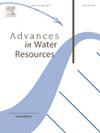基于神经算子的地质碳储量预测迁移学习
IF 4.2
2区 环境科学与生态学
Q1 WATER RESOURCES
引用次数: 0
摘要
地质碳储存(GCS)是将二氧化碳封存在地下深处的关键。GCS项目可能面临环境挑战,如泄漏风险、不利压力积聚和地下水污染。数值模拟器在准确预报中起着至关重要的作用,但在计算上可能很昂贵。在这项工作中,我们利用更新的傅立叶神经算子(FNO),其中包括数据稀疏性管理,来学习快速预测地质碳储存(GCS)储层的压力和二氧化碳相饱和度分布。与商业油藏模拟器相比,基于fno的预测提供了准确的预测,同时将计算时间减少了40倍,可以在更短的时间内进行大量预测。此外,我们应用迁移学习(TL)进一步减少了基于fno的预测在各种场景下的数据和计算需求。具体来说,我们证明了TL在不确定和可变的地质和操作条件下准确预测压力和二氧化碳饱和度分布的有用性。研究结果表明,改进的FNO工作流程将计算时间减少了约97%,预测CO2饱和度和压力分布的相对平均误差为1%。一般来说,使用TL可以有效地将知识从预先存在的模型转移到其他相关任务中。TL显着减少了所需训练数据的78%,同时保持相对平均误差低于5%。虽然这项工作的结果还可以进一步改进,但这项研究表明,在GCS项目中,整合FNO和TL可以减少CO2预测的计算时间和数据需求,提供了一种更高效、更快速的方法。本文章由计算机程序翻译,如有差异,请以英文原文为准。
Transfer learning for geological carbon storage forecasting using neural operator
Geological carbon storage (GCS) is critical for sequestering CO2 deep underground. GCS projects may face environmental challenges, such as leakage risks, adverse pressure buildup, and groundwater contamination. Numerical simulators play a vital role in accurate forecasting but can be computationally expensive. In this work, we leveraged an updated Fourier Neural Operator (FNO) which includes data sparsity management, to learn to rapidly forecast pressure and CO2 phase saturation distributions in a geological carbon storage (GCS) reservoir. Compared to commercial reservoir simulators, FNO-based forecasting offers accurate prediction while reducing the computational time by a factor of 40, enabling high volume of forecasting in less time. Additionally, we applied transfer learning (TL) to further reduce the data and computational requirements of the FNO-based forecasting across a wide array of scenarios. Specifically, we demonstrated the usefulness of TL in accurately predicting the pressure and CO2 saturation distributions for uncertain and variable geological and operational conditions. The results of this study indicate that the improved FNO workflow reduces the computational time by approximately 97 %, and the relative mean error for predicting both CO2 saturation and pressure distributions is <1 %. Generally, the use of TL effectively transfers knowledge from a pre-existing model to other related tasks. TL significantly reduces the required training data by 78 % while maintaining a relative mean error below 5 %. Although, the results in this work can be further improved, this study demonstrates the potential of integrating FNO and TL to reduce computational time and data requirements for CO2 forecasts during GCS projects, providing a more efficient and faster approach.
求助全文
通过发布文献求助,成功后即可免费获取论文全文。
去求助
来源期刊

Advances in Water Resources
环境科学-水资源
CiteScore
9.40
自引率
6.40%
发文量
171
审稿时长
36 days
期刊介绍:
Advances in Water Resources provides a forum for the presentation of fundamental scientific advances in the understanding of water resources systems. The scope of Advances in Water Resources includes any combination of theoretical, computational, and experimental approaches used to advance fundamental understanding of surface or subsurface water resources systems or the interaction of these systems with the atmosphere, geosphere, biosphere, and human societies. Manuscripts involving case studies that do not attempt to reach broader conclusions, research on engineering design, applied hydraulics, or water quality and treatment, as well as applications of existing knowledge that do not advance fundamental understanding of hydrological processes, are not appropriate for Advances in Water Resources.
Examples of appropriate topical areas that will be considered include the following:
• Surface and subsurface hydrology
• Hydrometeorology
• Environmental fluid dynamics
• Ecohydrology and ecohydrodynamics
• Multiphase transport phenomena in porous media
• Fluid flow and species transport and reaction processes
 求助内容:
求助内容: 应助结果提醒方式:
应助结果提醒方式:


